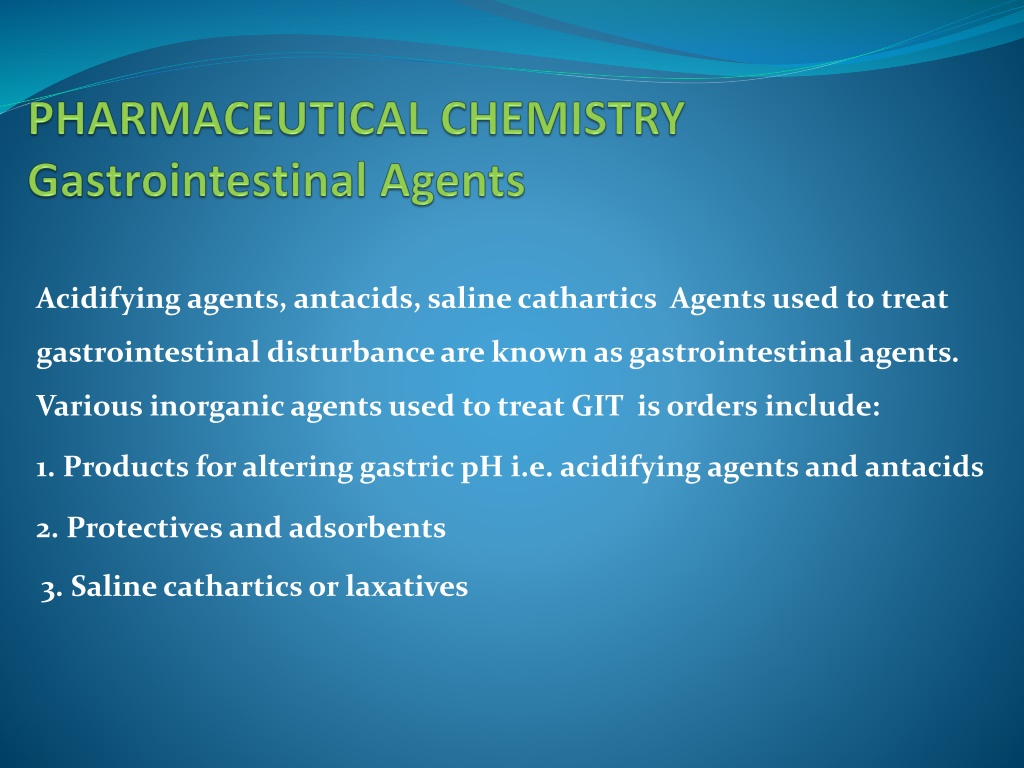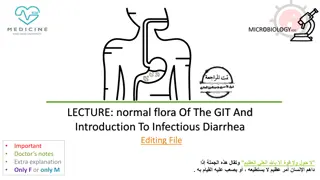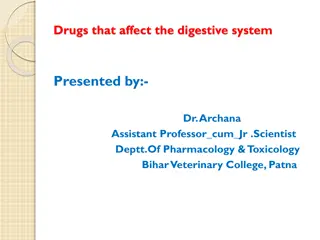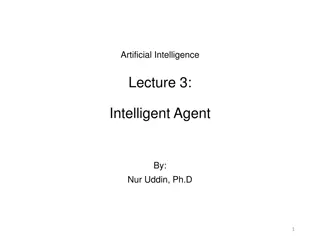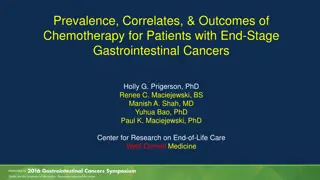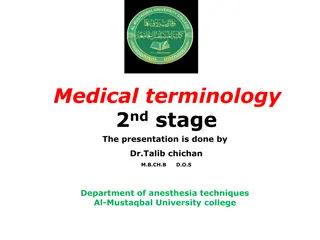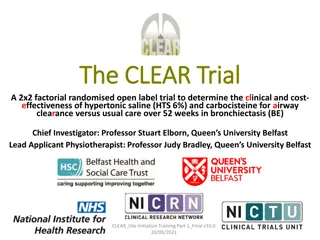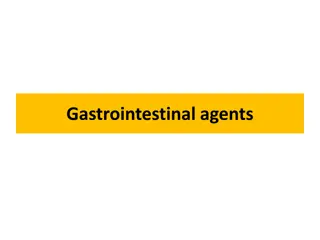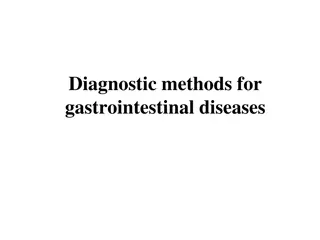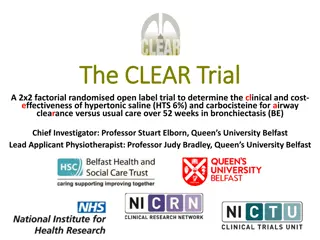Understanding Gastrointestinal Agents: Acidifying Agents, Antacids, Saline Cathartics
Gastrointestinal agents such as acidifying agents, antacids, and saline cathartics are used to manage gastrointestinal disturbances. Acidifying agents like Hydrochloric Acid aid in gastric digestion, while antacids help reduce gastric acidity. Saline cathartics are used as laxatives. Achlorhydria, a condition characterized by low or absence of gastric acid, can be treated with acidifying agents like ammonium chloride and dilute HCl. Antacids work by neutralizing gastric acidity. This comprehensive guide explores the uses, types, and treatments involving these important gastrointestinal agents.
Download Presentation

Please find below an Image/Link to download the presentation.
The content on the website is provided AS IS for your information and personal use only. It may not be sold, licensed, or shared on other websites without obtaining consent from the author. Download presentation by click this link. If you encounter any issues during the download, it is possible that the publisher has removed the file from their server.
E N D
Presentation Transcript
Acidifying agents, antacids, saline cathartics Agents used to treat gastrointestinal disturbance are known as gastrointestinal agents. Various inorganic agents used to treat GIT is orders include: 1. Products for altering gastric pH i.e. acidifying agents and antacids 2. Protectivesand adsorbents 3. Saline cathartics or laxatives
Acidifying Agents The pH of stomach is 1.5 -2 when empty and rises to pH 5-6 when food is ingested. The pH of stomach is so low because of the secretion of HCl. Gastric HCl act by destroying the bacteria in the ingested food and drinks. It softens the fibrous food and promotes the formation of the proteolytic enzyme pepsin. This enzyme is formed from pepsinogen at acidic pH (>6). Pepsin helps in the metabolism of proteins in the ingested food. Therefore lack of HCl in the stomach can cause Achlorhydria.
types of achlorhydria are known: 1) where the gastric secretion is devoid of HCl, even after stimulation with histamine phosphate 2) where gastric secretion is devoid of HCl, but secreted upon stimulation with histamine phosphate.
The cause of achlorhydria in first case may be subtotal gastrectomy, atrophic gastritis, carcinoma, gastric polyp etc while in later case it may be chronic nephritis, tuberculosis, hyperthyroidism, chronic alcoholism, sprue, pellagra etc. The symptoms vary with associated disease but they generally include mild diarrhoea or frequent bowl movement, epigastric pain and sensitivity to spicy food.
Achlorhydria can be treated by various acidifying agents like ammonium chloride, dilute HCl, Calcium chloride etc. Dilute Hydrochloric Acid HCl M.W 36.5 The acid should be diluted with 25-50 volumes with water or juice and sipped through a glass tube to prevent reaction upon dental enamel. It is taken during or after meals given in conjunction with iron therapy in hyper chromic anemia. Preparation: It is prepared by mixing 274gm of HCl and 726 gm of purified water.
Antacids Antacids are the substances which reduce gastric acidity resulting in an increase in the pH of stomach and duodenum. Gastric acidity occurs due to excessive secretion of HCl in stomach due tovarious reasons. The pH of the stomach is 1.5- 2.5 when empty and raises to 5-6 when food is ingested. Low pH is due to the presence of endogenous HCl, which is always present underphysiological conditions.
When hyperacidity occurs the result can range from: 1) gastritis (a general inflammation of gastric mucosa) 2) peptic ulcer or oesophageal ulcer ( lower end of oesophagus) 3) gastric ulcer (stomach) 4) duodenum ulcers Peptic ulcers occur due to defective oesophageal sphinter as in hiatal hernia. Gastric ulcers occur in lesser curvature and are found in first portion of duodenum.
Symptoms include uncomfortable feeling from over eating, heart burn, growing hungry between meals.Complications involved are hemorrhage (being more common with duodenal ulcers), perforation. Depending upon the severity and location of an ulcer treatment will range from diet and antacids and /or anticholinergic therapy to complete bed rest to surgery. Small meals after short interval help in reducing acidity, stimulants of gastric acid must be avoided like coffee, alcohol, spicy food, oil or fried food.
Antacid therapy: Antacids are alkaline bases used to neutralize the excess gastric HCl associated with gastritis or peptic ulcer. Since gastric HCl secretion is continuous, so is the administration of antacids. Roleof antacids: 1) Primarily in pain relief 2) Higher doses given continuously can promote ulcer healing 3) Superiorto H2 blockers in bleeding peptic ulcers
Criteria for antacids: i) The antacid should not be absorber/or cause systemic alkalosis ii) It should not be constipativeor laxative iii) It should exert effect rapidly and over a long period of time iv) The antacid should buffer in the range of pH 4-6 v) Reaction of antacid with HCl should not cause large evolution of gas.
Side effects of long term antacid therapy: a) If pH raises too high rebound acidity to neutralize the alkali occurs. b) Antacids which absorbed systemically exert alkaline effect on body s buffersystem. c) Some antacids cause constipation while others have laxativeeffect. d) Sodium containing antacids are problem for patients on sodium restricted diet.
Systemic antacids: Systemic antacids are antacids which get systemically absorbed e.g. sodium carbonate is water soluble and potent neutralizer, but it is not suitable for the treatment of peptic ulcer because of risk of ulcer perforation due to productionof carbon dioxide in the stomach. Systemic absorption leads to alkalosis, may worsen edema and congestive heart failure becauseof sodium ion load.
Non Systemic antacids They are insoluble and poorly absorbed systemically. In Magnesium salt, Magnesium carbonate is most water soluble and reacts with HCl at a slow rate, while Magnesium hydroxide has low solubility and has the power to absorb and inactivate pepsin and to protect the ulcer base. Aluminium hydroxide is a weak and slow reacting antacid. The aluminium ions relax smooth muscles and cause constipation. It absorbs pepsin at pH>3 and releases it at lower pH. It also prevents phosphate absorption. Calcium carbonate is a potent antacid with rapid acid neutralizing capacity, but on long term use, it can cause hypercalcemia, hypercalciuriaand formation of calcium stone in kidney.
Every single compound among antacid have some side effect especially when used for longer period or used in elderly patients. To avoid certain side effects associated with antacids,
combinations of antacids are used such as : (i) Magnesium and aluminium containing preparation e.g. magnesium hydroxide a fast acting antacid with aluminium hydroxide which is a slow acting antacid. (ii) Magnesium and calcium containing preparation where one is laxative and the later one is constipative in nature.
Compounds used as Antacids (i)Sodium Bicarbonate (Baking soda) NaHCO3 M.W. 84.01 Properties: White crystalline powder, odorless, with saline and slight alkaline taste, Stable in dry air, sparingly soluble in water, insoluble in alcohol. Use: It is used as antacid, and in electrolytereplacement.
(ii) Aluminium Hydroxide Al(OH)3M. W. = 78.0 Aluminium hydroxide gel is an aqueous suspension of hydrated aluminium oxidewith 3 differentamountsof basicaluminium carbonateand bicarbonate. Properties: Aluminium hydroxide is a white, light odorless, tasteless amorphous powder. It is soluble in dilute mineral acids and in solution of alkali hydroxides but practically insoluble in water. It forms gel on prolonged contact with water at pH 5.5-8.0. It absorbs acids and carbon dioxide. The aluminium hydroxide gels are ideal buffers in the pH 3-5 range due to its amphoteric nature.
Uses: Aluminium hydroxide is used as antacid in the management of peptic ulcer, gastritis, gastric hyperacidity. It is also used as skin protectant and mild astringent. (iii) Aluminium Phosphate AlPO4M.W. =122.0 Aluminium phosphate consists of hydrated aluminium orthophosphate. Use: It is used as antacid.
(iv) DihydroxyAluminium Ammonium Acetate Properties: It exists as very fine powder, bland taste, insoluble in water but forms suspension with water. Use: It is used as antacid. (v) DihydroxyAluminium Sodium Carbonate .W.=143.99 Use: It is used as antacid.
(vi)Calcium Carbonate (precipitated chalk) Ca CO3 M.W. = 100 Calcium carbonate is found in nature as limestone, marble, calcite, vaterite, aragonite and shell of sea animals. I.P. limit: It contains not less than 98% and not more than 100.5% with reference to dried substance. Properties: It occurs as a white, odorless tasteless microcrystalline powder which is stable in air. It exists in two crystal form and both are of commercial importance, one Aragonite and other is Calcite. Precipitated chalk is prepared as a fine precipitate by adding a solution of ammonium carbonate and ammonia or sodium carbonate to a solution of calcium nitrate.
cont. with Calcium Carbonate. Uses: It is used as fast acting antacid, in calcium deficiency, dentrifries and in combination with magnesium containing antacids due to its constipative properties. (vii)Tribasic Calcium Phosphate Properties: It is a white odourless, tasteless, amorphous powder practically insoluble in water, alcohol or acetic acid but readily soluble in dilute HCl and HNO Use: It is used as antacid, as non hygroscopic diluent, as an abrasive in tooth pastes.
(viii) Magnesium Carbonate Magnesium carbonate is a hydrated basic magnesium carbonate containing 40-45% of magnesium oxide. It occurs in nature as the meniral magnate and lansfordite. Heavy Magnesium Carbonate: 15 g occupyavolumeof about 30ml Light Magnesium Carbonate: 15 g occupyavolumeof about 150ml Uses: It is used as antacid and mild laxative. It is used as pharmaceutical aid (dispensing volatileoil foruse in inhalants).
(ix) Magnesim Oxide (Magnesia) MgO M.W. = 40.3 It occurs in nature as mineral periclase. It occurs in two varieties heavy magnesium oxide which is relatively dense white powder with 15 g occupying volume of about 30ml while light magnesium oxide is very bulky with 15 g occupying volumeof about 150ml. Uses: It is used as antacid and laxative. It is ingredient of universal antidote along with tannic acid and charcoal. It is used for compounding and preserving fluid extract because of itsabsorptive power.
(x)Magnesium Phosphate Mg3(PO4)2M.W. = 352.93 Uses: It is used as antacid and laxative. (xi)Magnesium Trisilicate Mg2O8Si3M.W. (anhydrous) =260.86 Uses: It is used as non systemicantacid and adsorbent.
Protectives and Adsorbents Compounds used as Protectivesand Adsorbents (i)Bismuth Subcarbonate Uses: Topically as protective in lotions and ointments, Internally as astringent and absorbent. It is also used as adsorbent in enteritis, diarrhoea, dysentery, ulcerativecolitis, in wound dressing.
(ii) Bismuth Subgallate Use: It is used as astringent, antacid and protective. (iii) Kaolin Heavy kaolin is purified natural hydrated aluminium silicateof variablecomposition. Light kaolin is native hydrated aluminum silicate free from most of its impurities by elutriation and dried. It may contain a suitabledispersing agent.
Cont. with kaolin.. Use: It is used as adsorbent in diarrhoea caused by agents capable of being absorbed e.g due to food poisoning. Also used in chronic ulcerative colitis. As poultice, dusting powder, clarifying and decolorizing medium, as filtering medium, as tabletdiluent. (iv) Activated Charcoal Absorbing power should not be less than 40% of weight of phenazone calculated with reference to the dried substance.
Saline Cathartics Saline cathartics or purgatives are agents that quicken and increase evacuation from the bowl. Laxatives are mild cathartics. Cathartics are used: to ease defecation in patients with painful hemorrhoids or other rectal disorders and to avoid excessive straining and concurrent increase in abdominal pressure in patientswith hernias Or to avoid potentially hazardous rise in B.P. during defecation in patients with hypertension, cerebral coronaryorotherarterial disease Or to relieveacuteconstipation Or to remove solid material from intestinal tract prior to certain roentgenographicstudies.
Laxative should only be used for short term therapy as prolonged use may lead to loss of spontaneous bowl rhythm upon which normal evacuation depends, causing patient to become dependent on laxatives, the so called laxative effect. Constipation is the infrequent or difficult evacuation of the feces. It may be due to a person resisting the natural urge to defecate, causing the fecal material which remains in the colon to lose fluid and to become relatively dry and hard.
Constipation can also be due to intestinal atony, intestinal spasm, emotions, drugs and diet. Many a time constipation can be helped by eating food such as natural laxatives or food with large roughages. Four types of laxatives are known: 1. Stimulants 2. Bulk forming 3. Emollient 4. Saline cathartics
Stimulants act by local irritation on the intestinal tract which increase peristaltic activity. They include phenolphthalein, aloin, cascara extract, rhubarb extract, senna extract, podophyllin, castor oil, bisacodyl, calomel etc. Bulk forming laxatives are made from cellulose, sodium carboxyl methyl cellulose and karaya gum. emollient laxatives act either as lubricants facilitating the passage of compacted fecal material or as stool softeners. E.g mineral oil, d-octyl sodium sulfosuccinate, an anionic surface active agent.
Saline cathartics act by increasing the osmotic load of the GIT. They are salts of poorly absorbable anions (biphosphate), (phosphate), sulphates, tartarates, and soluble magnesium salt. Saline cathartics are water soluble and are taken with large quantities of water. This prevents excessive loss of water from body fluids and reduces nausea vomiting if a too hypertonic solution should reach the stomach. They act in the intestine and a full cathartic dose produces a water evacuation within 3-6 hrs. Because of their quick onset of action they are given early in the morning before breakfast.
They are used for bowel evacuation before radiological, endoscopic and surgical procedures and also to expel parasite and toxic materials. Small amounts of these drugs may be absorbed in the blood causing occasional toxicity. The absorption of magnesium may cause marked CNS depression while that of sodium worsens the existing congestive cardiac failure (CCF).
Compounds used as Saline cathartics i)Sodium Acid Phosphate (sodium biphosphate) M.W. = 156.01 Properties: Colorless, odorless, crystalline powder with saline acidic taste. Freely soluble in water and practically in soluble in alcohol. Slightly deliquescent. Use: It is used as saline cathartic and as buffer in pharmaceutical preparations. As urinary acidifier, source of phosphorous.
ii)Disodium Hydrogen Phosphate (phosphor soda) M.W. = 358.14 Use: Widely used as saline cathartic. Orally as antihypercalcemic It is a pharmaceutical aid used as buffering agent. (iii) Sodium Potassium Tartarate M.W. = 282.22 Uses: It is used as laxative, food additive, as stabilizer in cheese and meet products.
(iv) Magnesium Sulphate M.W. = 246.47 Uses: It is used as osmotic laxative, in treatment of electrolyte deficiency, in wet dressing in boils, in treatment of cholecystitis, sea sickness, hypertension etc. (v)Calomel HgCl M.W. = 236.1 Uses: It is used as cathartic.
